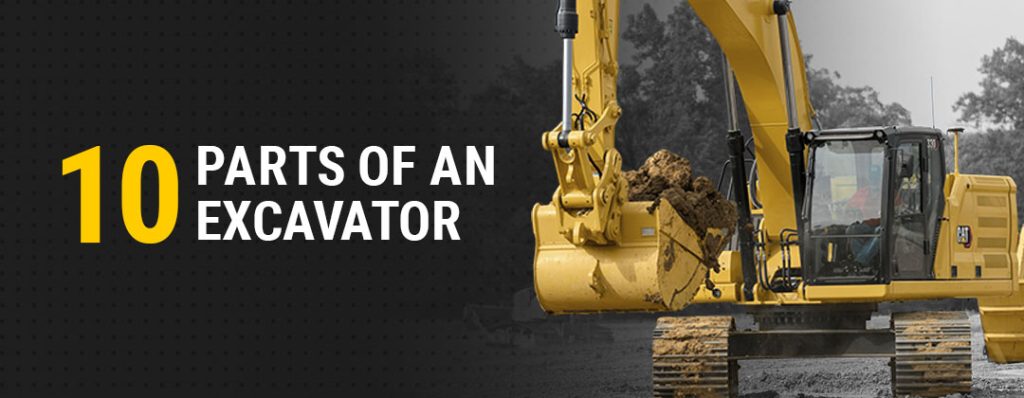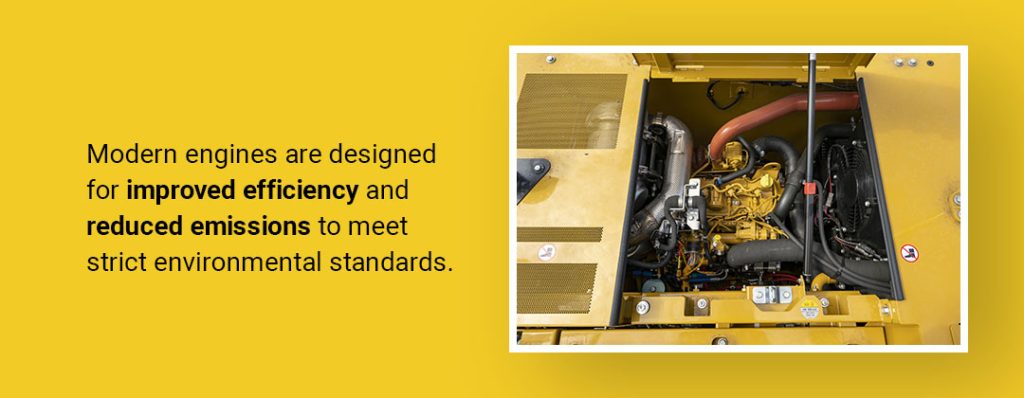
Before working with excavators, you need to know how they work. Excavators are essential heavy construction machines designed for digging, moving and lifting materials. They help make construction and excavation projects safer and more efficient. Understanding what the basic parts of an excavator are can help you be a better operator. Learn the excavator’s components and functions in this guide.
Knowing the basic parts of an excavator and how they work can help you choose, work with and maintain your machine. You’ll know what each part is, what it does and how everything fits together. Here are the main excavator components:
The boom is a fundamental component of an excavator. This large main part extends outward from the machine’s body. It primarily provides the excavator with its reach, allowing the operator to position the arm and bucket precisely for digging, lifting or placing materials. Booms come in various lengths and configurations, depending on the excavator’s intended application. Long booms are generally used for tasks requiring an extended reach, while shorter booms are better for confined spaces.
The arm, also called the stick, connects the boom to the bucket and helps control the excavation’s depth and precision. By extending and retracting the arm, the operator can adjust the distance between the boom and bucket, enabling precise digging, grading and lifting. The arm’s length varies depending on the excavator’s size. While mini excavators have shorter arms for better maneuverability in tight spaces, larger excavators have longer sticks, allowing for deep excavations.
The bucket is the attachment at the end of the arm responsible for digging, scooping and carrying materials. Buckets come in various shapes and sizes, each designed for specific tasks. Excavator buckets typically have teeth or cutting edges for breaking through tough soil or rock. They can be swapped out for other attachments, like grapples or thumbs, to expand the excavator’s capabilities. The bucket’s size and shape significantly affect productivity and efficiency, so choosing the right one for the application is important.
The cab is the operator’s compartment. It contains the operator’s seat and the control panel. From here, the operator manages the machine’s functions, using various controls, joysticks and pedals to operate the boom, arm, bucket and other movements like rotation and travel. Modern excavator cabs are equipped with air conditioning, ergonomic seating and advanced technology, enhancing operator safety, comfort and productivity.
The excavator’s undercarriage supports the machine’s weight, provides stability and facilitates movement. It includes tracks or wheels, depending on the excavator type. Tracks offer excellent traction and weight distribution, enabling crawler excavators to navigate rough and uneven terrains more easily. Wheeled excavators provide maximum agility on smoother surfaces such as asphalt and allow more mobility. The undercarriage may have features like adjustable width or retractable tracks to adapt to various job site conditions, ensuring the excavator’s stability and maneuverability.

Excavator engines usually run on diesel fuel. The engine’s size and power output depend on how big the excavator is and how it’s used. Modern engines are designed for improved efficiency and reduced emissions to meet strict environmental standards. Engines power the excavator’s movements and supply the energy needed to operate the hydraulic system.
The excavator’s hydraulic system is a complex network of high-pressure hoses, pumps, valves and cylinders that control the movements of the boom, arm and bucket. Using the hydraulic system, the operator manipulates these components to complete tasks. The hydraulic system is exceptionally responsive and powerful, making it an essential part of the excavator. It provides the strength needed to carry out heavy-duty tasks while maintaining accuracy and control in the operator’s hands.
The counterweight is a heavy component, often located at the excavator’s rear. It provides balance and stability during lifting and digging operations. Since the excavator’s bucket at the front is frequently loaded with materials in the bucket, the counterweight opposes the weight of these materials to prevent the excavator from tipping over. Counterweights are adjustable and can be tailored to the machine’s specific requirements, ensuring safe operation and preventing accidents.
Swing gear, typically loaded at the machine’s base, allows the excavator to perform a 360-degree rotation. This feature is essential for positioning the bucket accurately and efficiently without needing to reposition the entire machine. The operator can easily swing the excavator to reach different work site areas. It greatly enhances productivity and versatility, as the excavator can work within a wider radius without physically moving the undercarriage.
Some excavators are equipped with an optional blade at the front end for leveling and grading tasks. The operator can adjust this blade to control the grading depth and angle, making it a critical feature for projects requiring precise earthwork and leveling. The blade complements the excavator’s digging and material-handling capabilities, transforming it into a versatile machine for site preparation and finish grading work.
Here are the answers to some common excavator questions to help you learn more about these machines and how to keep them in good condition.
Excavators use a combination of the boom, stick, bucket and hydraulic system to dig, scoop and lift materials. The operator controls these functions from the cab. The hydraulic system activates these components, allowing the excavator to dig into the earth, scoop materials, and perform precision tasks like trenching or loading trucks.
Excavators come in different types to suit diverse needs. Standard crawler excavators are versatile and excel at many tasks. Mini excavators are compact and ideal for tight spaces, while wheeled excavators offer mobility on the road. Long-reach excavators extend for specialized reach and depth requirements. Your choice of excavator depends on the specific job and its demands.
Excavators find extensive use across construction and excavation projects. They’re essential for digging trenches, excavating building foundations, leveling and grading land, demolishing structures, and loading or unloading heavy materials. Their adaptability and precise control make them indispensable on job sites.
The boom and arm, undercarriage and cab are the 3 major parts of an excavator.
An excavator can not unscrew itself. Excavator parts are securely bolted, and the rotating cab is designed to stay firmly attached to the base.
With a legacy of excellence, Cat® excavators are renowned for their reliability, power and innovation. Whether you need a compact mini excavator or a heavy-duty crawler, we have the solution. Gregory Poole is your trusted partner in acquiring and maintaining Cat excavators. Our experts are ready to assist you in selecting the right equipment for your needs and provide top-notch service and support throughout your ownership. Explore our range of equipment today and elevate your construction and excavation projects with the best in the industry. Reach out if you have any questions.
{ “@context”: “https://schema.org”, “@type”: “VideoObject”, “name”: “Shop Smart: Get Cat Parts Online Anytime, Anywhere!”, “description”: “This video provides an overview of ordering parts from Parts.Cat.Com”, “thumbnailUrl”: “https://img.youtube.com/vi/Lgf7HD4WO-M/hqdefault.jpg”, “uploadDate”: “2024-02-27”, “duration”: “PT32S”, “contentUrl”: “https://www.youtube.com/watch?v=Lgf7HD4WO-M”, “embedUrl”: “https://www.youtube.com/embed/Lgf7HD4WO-M”, “interactionStatistic”: { “@type”: “InteractionCounter”, “interactionType”: “https://schema.org/WatchAction”, “userInteractionCount”: “795” } }